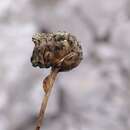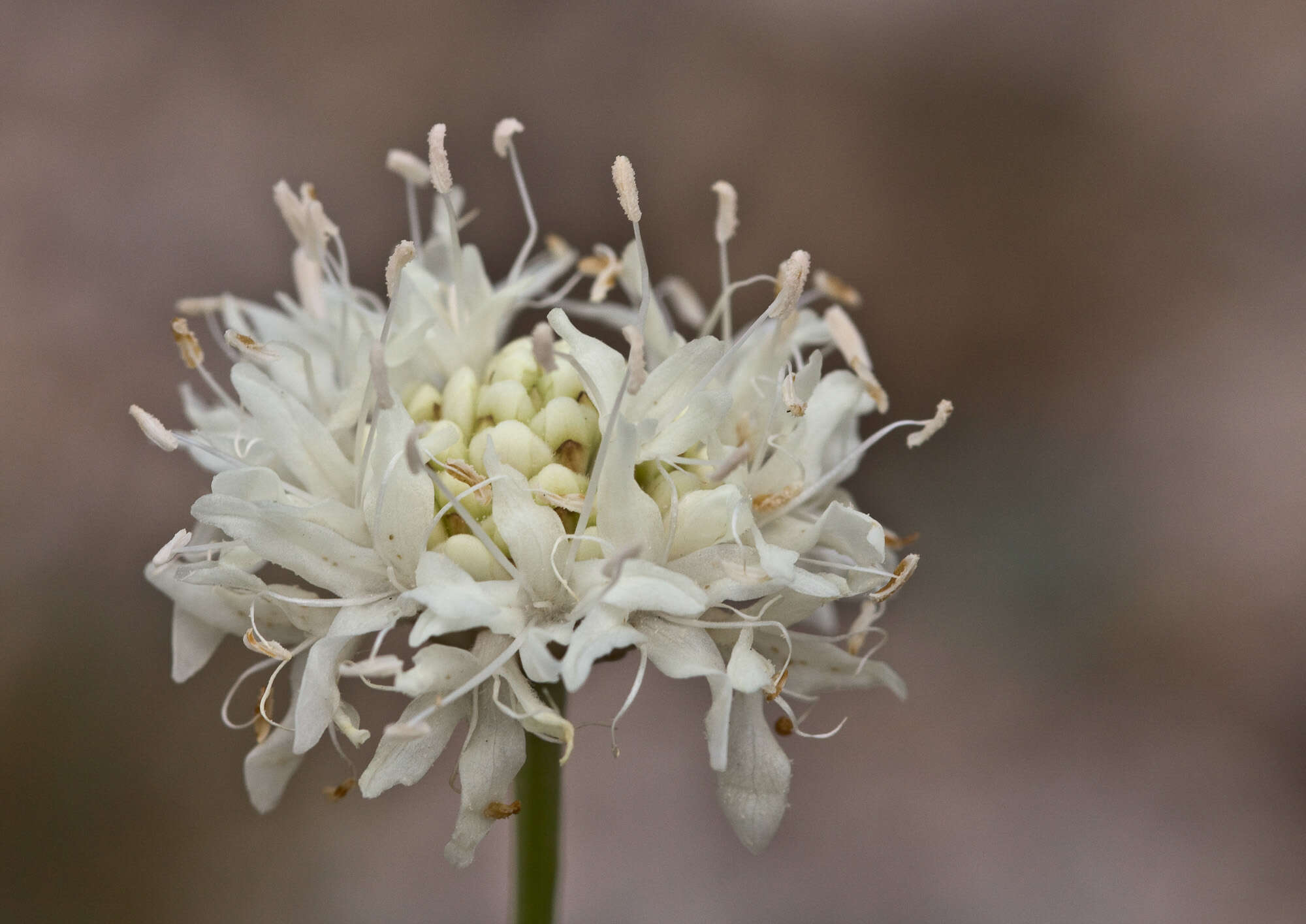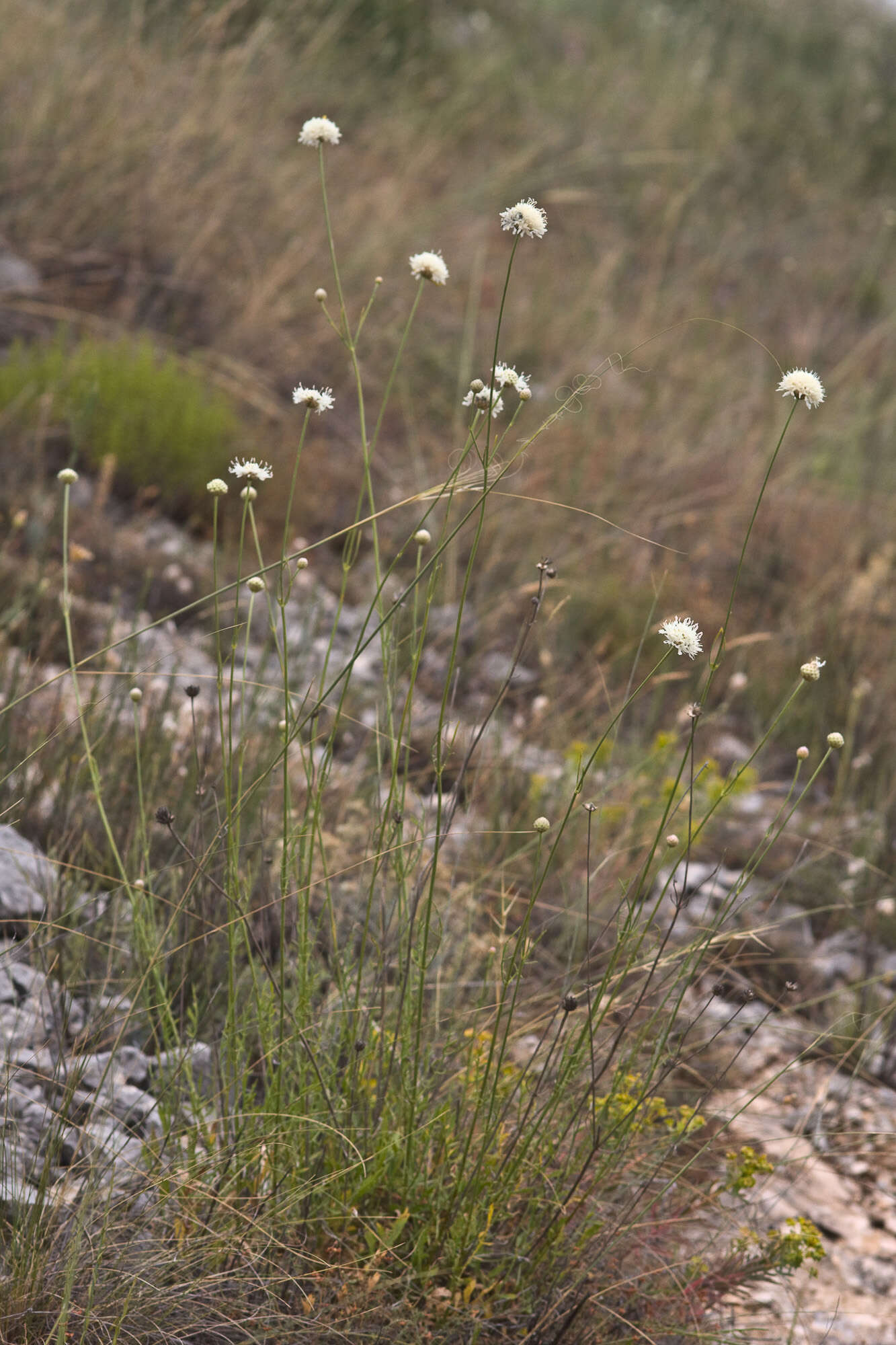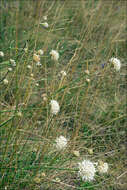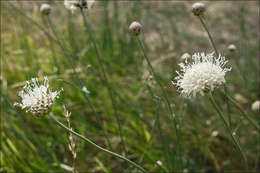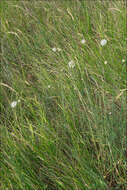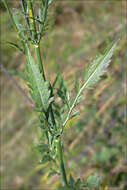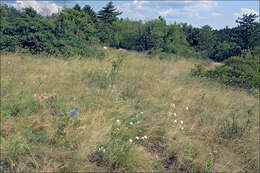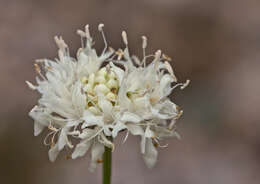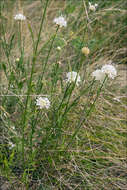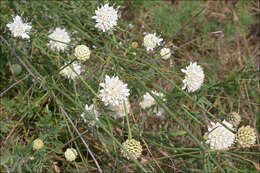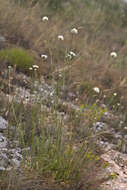-
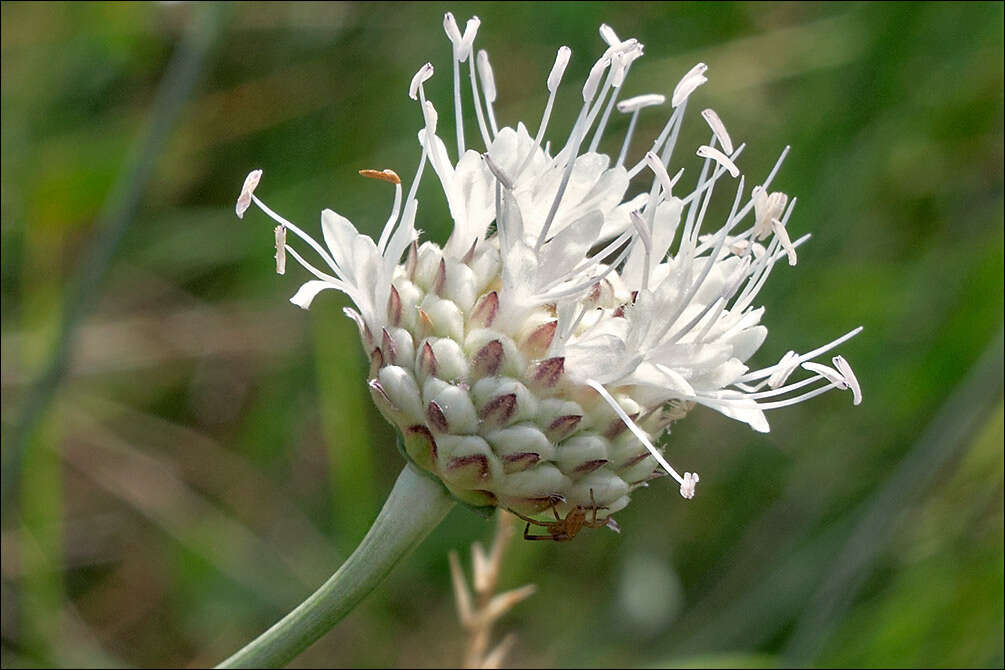
Cephalaria leucantha (L.) Roemer & Schultes, syn.: Scabiosa leucantha L., Scabiosa trenta HacquetEN: Giant Scabious, DE: Weier Schuppenkopf, Weibltiger Schuppenkopf, Weiblhender SchuppenkopfSlo.: bleda obloglavka, trentarski grintavecDat.: July 22. 2019 Lat.: 45.443873 Long.: 13.966619Code: Bot_1232/2019_DSC09021 Habitat: dry grassland partly overgrown with scattered trees and bushes, locally flat terrain, skeletal, calcareous ground; open, sunny, dry place; elevation 485 m (1.919 feet);average precipitations 1.800 2.000 mm/year, average temperature 9-10 deg C, sub-Mediterranean phytogeographical region. Substratum: soil.Place: South of village Rakitovec (Slovenia), Kraki rob place, 900 m south of Slovenia/Croatia border crossing Rakitovec, next to the road toward town Buzet, Istria, Croatia EC. Comment: Cephalaria leucantha is a plant with a special significance in the history of Slovenian botany. It was first described more than 200 years ago in 1782 by Balthasar Hacquet. He was a medical doctor and an important scholar of very wide scope, living in the town Idria. Amon other activities he intensively researched Slovenian flora, particularly high in the Alps. A that time he described to the first time a beautiful, pale yellow plant found somewhere on the south slopes of Mt. Triglav above the Trenta valley. Exact location was lost. A dried specimen and Hacquet's drawing of the plant still exist in the herbarium of the Natural History Museum in Ljubljana. He named the new species Scabiosa trenta after the valley Trenta (note that some time ago Cephalaria leucantha was moved from genus Scabiosa to genus Cephalaria). After that the plant apparently 'disappeared' and hence became a botany riddle. Many botanists had been searching for it for more than 100 years, but none successfully. The plant became a great source of inspiration for later botanists and mountaineers of that time, especially for Julius Kugy, a German of Slovenian descent. He was writer, botanist, humanist, lawyer, musician and the father of modern mountaineering in the Julian Alps. He had searched for his beloved 'princes', as he named it, for almost all of his life. Much later Austrian botanist Anton Kerner found by careful inspection of the plant in the herbarium in Ljubljana that it doesn't represent a new Alpine species, as Hacquet was convinced, but a much more south growing Mediterranean plant Scabiosa leucantha (today named Cephalaria leucantha). So, the riddle was solved. It is quite possible that the plant, which Hacquet found, was among the last of its species growing in the Julian Alps and is now extinct from this region. Scabiosa trenta on the slopes of Mt. Triglav was probably a relic of warmer times between last ice ages. During that time many southern plants protruded far north into Alpine regions and were pushed back to the south by following colder climate. Nevertheless, Scabiosa trenta remains a strong symbol in Slovenian botany.The pictures shown here were taken at Kraki rob place in Croatia just 500 m southwest of Slovenia/Croatia border. But the plant can be found also in Slovenia in its warmest, southwest regions, however only in a few MTB squares. It also enters the most southwest parts of the Alps.Ref.:(1) D. Aeschimann, K. Lauber, D.M. Moser, J.P. Theurillat, Flora Alpina, Vol. 2., Haupt (2004), p 404.(2) A. Martini et all., Mala Flora Slovenije (Flora of Slovenia - Key) (in Slovenian), Tehnina Zaloba Slovenije (2007), p 499. (3) W.K. Rottensteiner, Exkursionsflora fr Istrien, Verlag des Naturwissenschaftlichen Vereins Krten (2014), p 423.(4) M. Blamey, C. Grey-Wilson, Wild Flowers of the Mediterranean, A & C Black, London (2005), p 425.
-
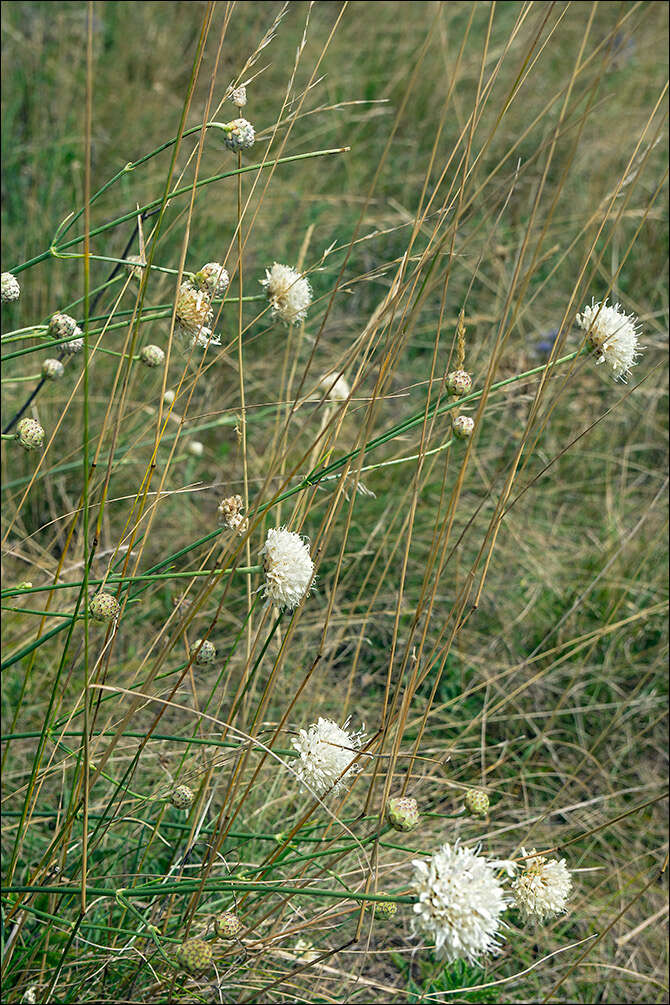
Cephalaria leucantha (L.) Roemer & Schultes, syn.: Scabiosa leucantha L., Scabiosa trenta HacquetEN: Giant Scabious, DE: Weier Schuppenkopf, Weibltiger Schuppenkopf, Weiblhender SchuppenkopfSlo.: bleda obloglavka, trentarski grintavecDat.: July 22. 2019 Lat.: 45.443873 Long.: 13.966619Code: Bot_1232/2019_DSC09021 Habitat: dry grassland partly overgrown with scattered trees and bushes, locally flat terrain, skeletal, calcareous ground; open, sunny, dry place; elevation 485 m (1.919 feet);average precipitations 1.800 2.000 mm/year, average temperature 9-10 deg C, sub-Mediterranean phytogeographical region. Substratum: soil.Place: South of village Rakitovec (Slovenia), Kraki rob place, 900 m south of Slovenia/Croatia border crossing Rakitovec, next to the road toward town Buzet, Istria, Croatia EC. Comment: Cephalaria leucantha is a plant with a special significance in the history of Slovenian botany. It was first described more than 200 years ago in 1782 by Balthasar Hacquet. He was a medical doctor and an important scholar of very wide scope, living in the town Idria. Amon other activities he intensively researched Slovenian flora, particularly high in the Alps. A that time he described to the first time a beautiful, pale yellow plant found somewhere on the south slopes of Mt. Triglav above the Trenta valley. Exact location was lost. A dried specimen and Hacquet's drawing of the plant still exist in the herbarium of the Natural History Museum in Ljubljana. He named the new species Scabiosa trenta after the valley Trenta (note that some time ago Cephalaria leucantha was moved from genus Scabiosa to genus Cephalaria). After that the plant apparently 'disappeared' and hence became a botany riddle. Many botanists had been searching for it for more than 100 years, but none successfully. The plant became a great source of inspiration for later botanists and mountaineers of that time, especially for Julius Kugy, a German of Slovenian descent. He was writer, botanist, humanist, lawyer, musician and the father of modern mountaineering in the Julian Alps. He had searched for his beloved 'princes', as he named it, for almost all of his life. Much later Austrian botanist Anton Kerner found by careful inspection of the plant in the herbarium in Ljubljana that it doesn't represent a new Alpine species, as Hacquet was convinced, but a much more south growing Mediterranean plant Scabiosa leucantha (today named Cephalaria leucantha). So, the riddle was solved. It is quite possible that the plant, which Hacquet found, was among the last of its species growing in the Julian Alps and is now extinct from this region. Scabiosa trenta on the slopes of Mt. Triglav was probably a relic of warmer times between last ice ages. During that time many southern plants protruded far north into Alpine regions and were pushed back to the south by following colder climate. Nevertheless, Scabiosa trenta remains a strong symbol in Slovenian botany.The pictures shown here were taken at Kraki rob place in Croatia just 500 m southwest of Slovenia/Croatia border. But the plant can be found also in Slovenia in its warmest, southwest regions, however only in a few MTB squares. It also enters the most southwest parts of the Alps.Ref.:(1) D. Aeschimann, K. Lauber, D.M. Moser, J.P. Theurillat, Flora Alpina, Vol. 2., Haupt (2004), p 404.(2) A. Martini et all., Mala Flora Slovenije (Flora of Slovenia - Key) (in Slovenian), Tehnina Zaloba Slovenije (2007), p 499. (3) W.K. Rottensteiner, Exkursionsflora fr Istrien, Verlag des Naturwissenschaftlichen Vereins Krten (2014), p 423.(4) M. Blamey, C. Grey-Wilson, Wild Flowers of the Mediterranean, A & C Black, London (2005), p 425.
-
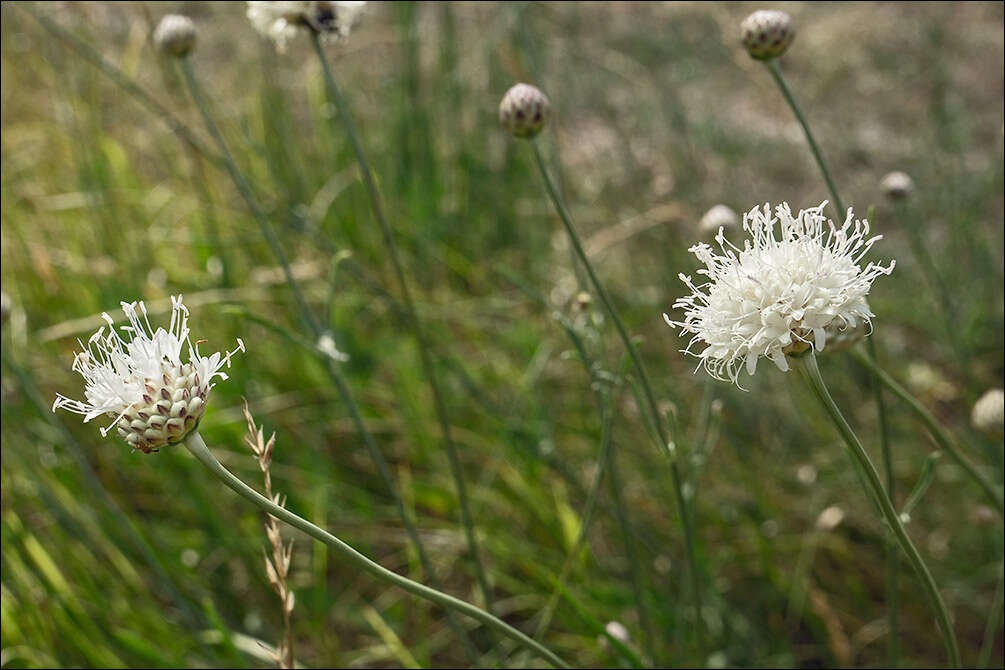
Cephalaria leucantha (L.) Roemer & Schultes, syn.: Scabiosa leucantha L., Scabiosa trenta HacquetEN: Giant Scabious, DE: Weier Schuppenkopf, Weibltiger Schuppenkopf, Weiblhender SchuppenkopfSlo.: bleda obloglavka, trentarski grintavecDat.: July 22. 2019 Lat.: 45.443873 Long.: 13.966619Code: Bot_1232/2019_DSC09021 Habitat: dry grassland partly overgrown with scattered trees and bushes, locally flat terrain, skeletal, calcareous ground; open, sunny, dry place; elevation 485 m (1.919 feet);average precipitations 1.800 2.000 mm/year, average temperature 9-10 deg C, sub-Mediterranean phytogeographical region. Substratum: soil.Place: South of village Rakitovec (Slovenia), Kraki rob place, 900 m south of Slovenia/Croatia border crossing Rakitovec, next to the road toward town Buzet, Istria, Croatia EC. Comment: Cephalaria leucantha is a plant with a special significance in the history of Slovenian botany. It was first described more than 200 years ago in 1782 by Balthasar Hacquet. He was a medical doctor and an important scholar of very wide scope, living in the town Idria. Amon other activities he intensively researched Slovenian flora, particularly high in the Alps. A that time he described to the first time a beautiful, pale yellow plant found somewhere on the south slopes of Mt. Triglav above the Trenta valley. Exact location was lost. A dried specimen and Hacquet's drawing of the plant still exist in the herbarium of the Natural History Museum in Ljubljana. He named the new species Scabiosa trenta after the valley Trenta (note that some time ago Cephalaria leucantha was moved from genus Scabiosa to genus Cephalaria). After that the plant apparently 'disappeared' and hence became a botany riddle. Many botanists had been searching for it for more than 100 years, but none successfully. The plant became a great source of inspiration for later botanists and mountaineers of that time, especially for Julius Kugy, a German of Slovenian descent. He was writer, botanist, humanist, lawyer, musician and the father of modern mountaineering in the Julian Alps. He had searched for his beloved 'princes', as he named it, for almost all of his life. Much later Austrian botanist Anton Kerner found by careful inspection of the plant in the herbarium in Ljubljana that it doesn't represent a new Alpine species, as Hacquet was convinced, but a much more south growing Mediterranean plant Scabiosa leucantha (today named Cephalaria leucantha). So, the riddle was solved. It is quite possible that the plant, which Hacquet found, was among the last of its species growing in the Julian Alps and is now extinct from this region. Scabiosa trenta on the slopes of Mt. Triglav was probably a relic of warmer times between last ice ages. During that time many southern plants protruded far north into Alpine regions and were pushed back to the south by following colder climate. Nevertheless, Scabiosa trenta remains a strong symbol in Slovenian botany.The pictures shown here were taken at Kraki rob place in Croatia just 500 m southwest of Slovenia/Croatia border. But the plant can be found also in Slovenia in its warmest, southwest regions, however only in a few MTB squares. It also enters the most southwest parts of the Alps.Ref.:(1) D. Aeschimann, K. Lauber, D.M. Moser, J.P. Theurillat, Flora Alpina, Vol. 2., Haupt (2004), p 404.(2) A. Martini et all., Mala Flora Slovenije (Flora of Slovenia - Key) (in Slovenian), Tehnina Zaloba Slovenije (2007), p 499. (3) W.K. Rottensteiner, Exkursionsflora fr Istrien, Verlag des Naturwissenschaftlichen Vereins Krten (2014), p 423.(4) M. Blamey, C. Grey-Wilson, Wild Flowers of the Mediterranean, A & C Black, London (2005), p 425.
-
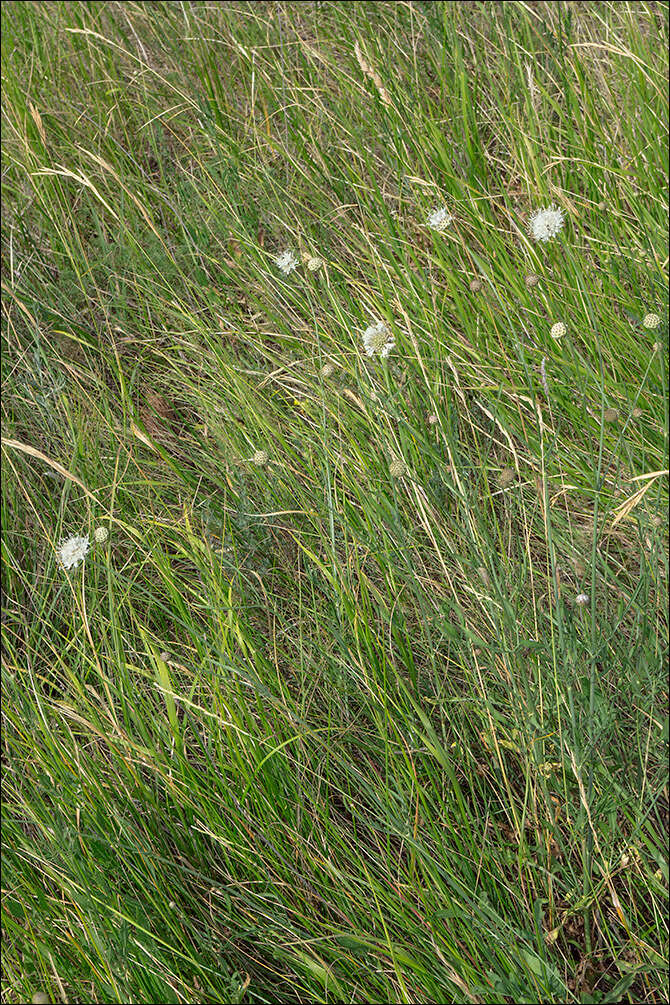
Cephalaria leucantha (L.) Roemer & Schultes, syn.: Scabiosa leucantha L., Scabiosa trenta HacquetEN: Giant Scabious, DE: Weier Schuppenkopf, Weibltiger Schuppenkopf, Weiblhender SchuppenkopfSlo.: bleda obloglavka, trentarski grintavecDat.: July 22. 2019 Lat.: 45.443873 Long.: 13.966619Code: Bot_1232/2019_DSC09021 Habitat: dry grassland partly overgrown with scattered trees and bushes, locally flat terrain, skeletal, calcareous ground; open, sunny, dry place; elevation 485 m (1.919 feet);average precipitations 1.800 2.000 mm/year, average temperature 9-10 deg C, sub-Mediterranean phytogeographical region. Substratum: soil.Place: South of village Rakitovec (Slovenia), Kraki rob place, 900 m south of Slovenia/Croatia border crossing Rakitovec, next to the road toward town Buzet, Istria, Croatia EC. Comment: Cephalaria leucantha is a plant with a special significance in the history of Slovenian botany. It was first described more than 200 years ago in 1782 by Balthasar Hacquet. He was a medical doctor and an important scholar of very wide scope, living in the town Idria. Amon other activities he intensively researched Slovenian flora, particularly high in the Alps. A that time he described to the first time a beautiful, pale yellow plant found somewhere on the south slopes of Mt. Triglav above the Trenta valley. Exact location was lost. A dried specimen and Hacquet's drawing of the plant still exist in the herbarium of the Natural History Museum in Ljubljana. He named the new species Scabiosa trenta after the valley Trenta (note that some time ago Cephalaria leucantha was moved from genus Scabiosa to genus Cephalaria). After that the plant apparently 'disappeared' and hence became a botany riddle. Many botanists had been searching for it for more than 100 years, but none successfully. The plant became a great source of inspiration for later botanists and mountaineers of that time, especially for Julius Kugy, a German of Slovenian descent. He was writer, botanist, humanist, lawyer, musician and the father of modern mountaineering in the Julian Alps. He had searched for his beloved 'princes', as he named it, for almost all of his life. Much later Austrian botanist Anton Kerner found by careful inspection of the plant in the herbarium in Ljubljana that it doesn't represent a new Alpine species, as Hacquet was convinced, but a much more south growing Mediterranean plant Scabiosa leucantha (today named Cephalaria leucantha). So, the riddle was solved. It is quite possible that the plant, which Hacquet found, was among the last of its species growing in the Julian Alps and is now extinct from this region. Scabiosa trenta on the slopes of Mt. Triglav was probably a relic of warmer times between last ice ages. During that time many southern plants protruded far north into Alpine regions and were pushed back to the south by following colder climate. Nevertheless, Scabiosa trenta remains a strong symbol in Slovenian botany.The pictures shown here were taken at Kraki rob place in Croatia just 500 m southwest of Slovenia/Croatia border. But the plant can be found also in Slovenia in its warmest, southwest regions, however only in a few MTB squares. It also enters the most southwest parts of the Alps.Ref.:(1) D. Aeschimann, K. Lauber, D.M. Moser, J.P. Theurillat, Flora Alpina, Vol. 2., Haupt (2004), p 404.(2) A. Martini et all., Mala Flora Slovenije (Flora of Slovenia - Key) (in Slovenian), Tehnina Zaloba Slovenije (2007), p 499. (3) W.K. Rottensteiner, Exkursionsflora fr Istrien, Verlag des Naturwissenschaftlichen Vereins Krten (2014), p 423.(4) M. Blamey, C. Grey-Wilson, Wild Flowers of the Mediterranean, A & C Black, London (2005), p 425.
-
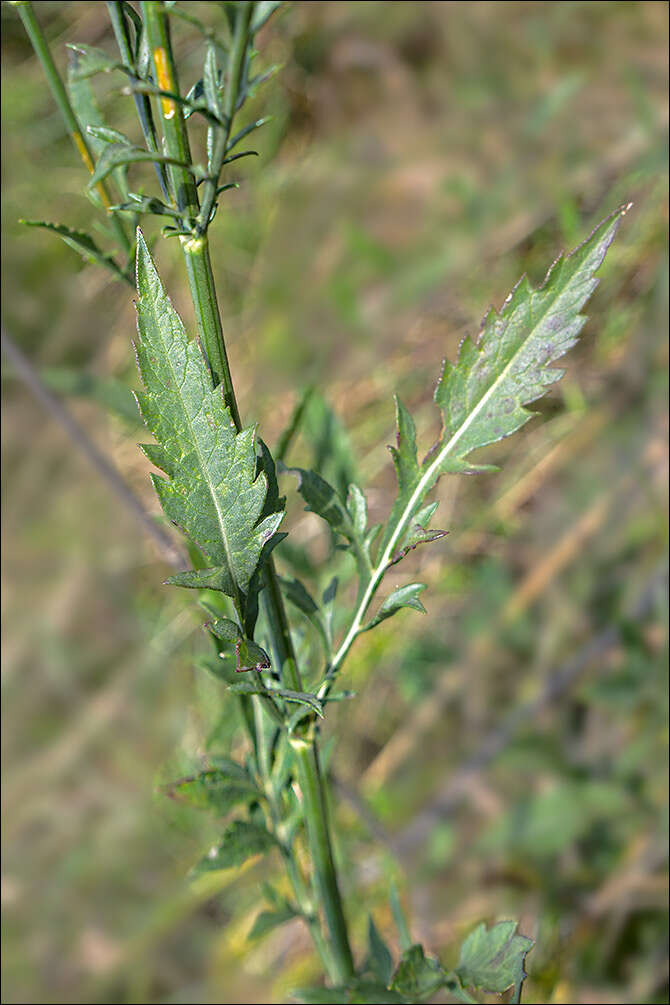
Cephalaria leucantha (L.) Roemer & Schultes, syn.: Scabiosa leucantha L., Scabiosa trenta HacquetEN: Giant Scabious, DE: Weier Schuppenkopf, Weibltiger Schuppenkopf, Weiblhender SchuppenkopfSlo.: bleda obloglavka, trentarski grintavecDat.: July 22. 2019 Lat.: 45.443873 Long.: 13.966619Code: Bot_1232/2019_DSC09021 Habitat: dry grassland partly overgrown with scattered trees and bushes, locally flat terrain, skeletal, calcareous ground; open, sunny, dry place; elevation 485 m (1.919 feet);average precipitations 1.800 2.000 mm/year, average temperature 9-10 deg C, sub-Mediterranean phytogeographical region. Substratum: soil.Place: South of village Rakitovec (Slovenia), Kraki rob place, 900 m south of Slovenia/Croatia border crossing Rakitovec, next to the road toward town Buzet, Istria, Croatia EC. Comment: Cephalaria leucantha is a plant with a special significance in the history of Slovenian botany. It was first described more than 200 years ago in 1782 by Balthasar Hacquet. He was a medical doctor and an important scholar of very wide scope, living in the town Idria. Amon other activities he intensively researched Slovenian flora, particularly high in the Alps. A that time he described to the first time a beautiful, pale yellow plant found somewhere on the south slopes of Mt. Triglav above the Trenta valley. Exact location was lost. A dried specimen and Hacquet's drawing of the plant still exist in the herbarium of the Natural History Museum in Ljubljana. He named the new species Scabiosa trenta after the valley Trenta (note that some time ago Cephalaria leucantha was moved from genus Scabiosa to genus Cephalaria). After that the plant apparently 'disappeared' and hence became a botany riddle. Many botanists had been searching for it for more than 100 years, but none successfully. The plant became a great source of inspiration for later botanists and mountaineers of that time, especially for Julius Kugy, a German of Slovenian descent. He was writer, botanist, humanist, lawyer, musician and the father of modern mountaineering in the Julian Alps. He had searched for his beloved 'princes', as he named it, for almost all of his life. Much later Austrian botanist Anton Kerner found by careful inspection of the plant in the herbarium in Ljubljana that it doesn't represent a new Alpine species, as Hacquet was convinced, but a much more south growing Mediterranean plant Scabiosa leucantha (today named Cephalaria leucantha). So, the riddle was solved. It is quite possible that the plant, which Hacquet found, was among the last of its species growing in the Julian Alps and is now extinct from this region. Scabiosa trenta on the slopes of Mt. Triglav was probably a relic of warmer times between last ice ages. During that time many southern plants protruded far north into Alpine regions and were pushed back to the south by following colder climate. Nevertheless, Scabiosa trenta remains a strong symbol in Slovenian botany.The pictures shown here were taken at Kraki rob place in Croatia just 500 m southwest of Slovenia/Croatia border. But the plant can be found also in Slovenia in its warmest, southwest regions, however only in a few MTB squares. It also enters the most southwest parts of the Alps.Ref.:(1) D. Aeschimann, K. Lauber, D.M. Moser, J.P. Theurillat, Flora Alpina, Vol. 2., Haupt (2004), p 404.(2) A. Martini et all., Mala Flora Slovenije (Flora of Slovenia - Key) (in Slovenian), Tehnina Zaloba Slovenije (2007), p 499. (3) W.K. Rottensteiner, Exkursionsflora fr Istrien, Verlag des Naturwissenschaftlichen Vereins Krten (2014), p 423.(4) M. Blamey, C. Grey-Wilson, Wild Flowers of the Mediterranean, A & C Black, London (2005), p 425.
-

Cephalaria leucantha (L.) Roemer & Schultes, syn.: Scabiosa leucantha L., Scabiosa trenta HacquetEN: Giant Scabious, DE: Weier Schuppenkopf, Weibltiger Schuppenkopf, Weiblhender SchuppenkopfSlo.: bleda obloglavka, trentarski grintavecDat.: July 22. 2019 Lat.: 45.443873 Long.: 13.966619Code: Bot_1232/2019_DSC09021 Habitat: dry grassland partly overgrown with scattered trees and bushes, locally flat terrain, skeletal, calcareous ground; open, sunny, dry place; elevation 485 m (1.919 feet);average precipitations 1.800 2.000 mm/year, average temperature 9-10 deg C, sub-Mediterranean phytogeographical region. Substratum: soil.Place: South of village Rakitovec (Slovenia), Kraki rob place, 900 m south of Slovenia/Croatia border crossing Rakitovec, next to the road toward town Buzet, Istria, Croatia EC. Comment: Cephalaria leucantha is a plant with a special significance in the history of Slovenian botany. It was first described more than 200 years ago in 1782 by Balthasar Hacquet. He was a medical doctor and an important scholar of very wide scope, living in the town Idria. Amon other activities he intensively researched Slovenian flora, particularly high in the Alps. A that time he described to the first time a beautiful, pale yellow plant found somewhere on the south slopes of Mt. Triglav above the Trenta valley. Exact location was lost. A dried specimen and Hacquet's drawing of the plant still exist in the herbarium of the Natural History Museum in Ljubljana. He named the new species Scabiosa trenta after the valley Trenta (note that some time ago Cephalaria leucantha was moved from genus Scabiosa to genus Cephalaria). After that the plant apparently 'disappeared' and hence became a botany riddle. Many botanists had been searching for it for more than 100 years, but none successfully. The plant became a great source of inspiration for later botanists and mountaineers of that time, especially for Julius Kugy, a German of Slovenian descent. He was writer, botanist, humanist, lawyer, musician and the father of modern mountaineering in the Julian Alps. He had searched for his beloved 'princes', as he named it, for almost all of his life. Much later Austrian botanist Anton Kerner found by careful inspection of the plant in the herbarium in Ljubljana that it doesn't represent a new Alpine species, as Hacquet was convinced, but a much more south growing Mediterranean plant Scabiosa leucantha (today named Cephalaria leucantha). So, the riddle was solved. It is quite possible that the plant, which Hacquet found, was among the last of its species growing in the Julian Alps and is now extinct from this region. Scabiosa trenta on the slopes of Mt. Triglav was probably a relic of warmer times between last ice ages. During that time many southern plants protruded far north into Alpine regions and were pushed back to the south by following colder climate. Nevertheless, Scabiosa trenta remains a strong symbol in Slovenian botany.The pictures shown here were taken at Kraki rob place in Croatia just 500 m southwest of Slovenia/Croatia border. But the plant can be found also in Slovenia in its warmest, southwest regions, however only in a few MTB squares. It also enters the most southwest parts of the Alps.Ref.:(1) D. Aeschimann, K. Lauber, D.M. Moser, J.P. Theurillat, Flora Alpina, Vol. 2., Haupt (2004), p 404.(2) A. Martini et all., Mala Flora Slovenije (Flora of Slovenia - Key) (in Slovenian), Tehnina Zaloba Slovenije (2007), p 499. (3) W.K. Rottensteiner, Exkursionsflora fr Istrien, Verlag des Naturwissenschaftlichen Vereins Krten (2014), p 423.(4) M. Blamey, C. Grey-Wilson, Wild Flowers of the Mediterranean, A & C Black, London (2005), p 425.
-
-

Cephalaria leucantha (L.) Roemer & Schultes, syn.: Scabiosa leucantha L., Scabiosa trenta HacquetEN: Giant Scabious, DE: Weier Schuppenkopf, Weibltiger Schuppenkopf, Weiblhender SchuppenkopfSlo.: bleda obloglavka, trentarski grintavecDat.: July 22. 2019 Lat.: 45.443873 Long.: 13.966619Code: Bot_1232/2019_DSC09021 Habitat: dry grassland partly overgrown with scattered trees and bushes, locally flat terrain, skeletal, calcareous ground; open, sunny, dry place; elevation 485 m (1.919 feet);average precipitations 1.800 2.000 mm/year, average temperature 9-10 deg C, sub-Mediterranean phytogeographical region. Substratum: soil.Place: South of village Rakitovec (Slovenia), Kraki rob place, 900 m south of Slovenia/Croatia border crossing Rakitovec, next to the road toward town Buzet, Istria, Croatia EC. Comment: Cephalaria leucantha is a plant with a special significance in the history of Slovenian botany. It was first described more than 200 years ago in 1782 by Balthasar Hacquet. He was a medical doctor and an important scholar of very wide scope, living in the town Idria. Amon other activities he intensively researched Slovenian flora, particularly high in the Alps. A that time he described to the first time a beautiful, pale yellow plant found somewhere on the south slopes of Mt. Triglav above the Trenta valley. Exact location was lost. A dried specimen and Hacquet's drawing of the plant still exist in the herbarium of the Natural History Museum in Ljubljana. He named the new species Scabiosa trenta after the valley Trenta (note that some time ago Cephalaria leucantha was moved from genus Scabiosa to genus Cephalaria). After that the plant apparently 'disappeared' and hence became a botany riddle. Many botanists had been searching for it for more than 100 years, but none successfully. The plant became a great source of inspiration for later botanists and mountaineers of that time, especially for Julius Kugy, a German of Slovenian descent. He was writer, botanist, humanist, lawyer, musician and the father of modern mountaineering in the Julian Alps. He had searched for his beloved 'princes', as he named it, for almost all of his life. Much later Austrian botanist Anton Kerner found by careful inspection of the plant in the herbarium in Ljubljana that it doesn't represent a new Alpine species, as Hacquet was convinced, but a much more south growing Mediterranean plant Scabiosa leucantha (today named Cephalaria leucantha). So, the riddle was solved. It is quite possible that the plant, which Hacquet found, was among the last of its species growing in the Julian Alps and is now extinct from this region. Scabiosa trenta on the slopes of Mt. Triglav was probably a relic of warmer times between last ice ages. During that time many southern plants protruded far north into Alpine regions and were pushed back to the south by following colder climate. Nevertheless, Scabiosa trenta remains a strong symbol in Slovenian botany.The pictures shown here were taken at Kraki rob place in Croatia just 500 m southwest of Slovenia/Croatia border. But the plant can be found also in Slovenia in its warmest, southwest regions, however only in a few MTB squares. It also enters the most southwest parts of the Alps.Ref.:(1) D. Aeschimann, K. Lauber, D.M. Moser, J.P. Theurillat, Flora Alpina, Vol. 2., Haupt (2004), p 404.(2) A. Martini et all., Mala Flora Slovenije (Flora of Slovenia - Key) (in Slovenian), Tehnina Zaloba Slovenije (2007), p 499. (3) W.K. Rottensteiner, Exkursionsflora fr Istrien, Verlag des Naturwissenschaftlichen Vereins Krten (2014), p 423.(4) M. Blamey, C. Grey-Wilson, Wild Flowers of the Mediterranean, A & C Black, London (2005), p 425.
-
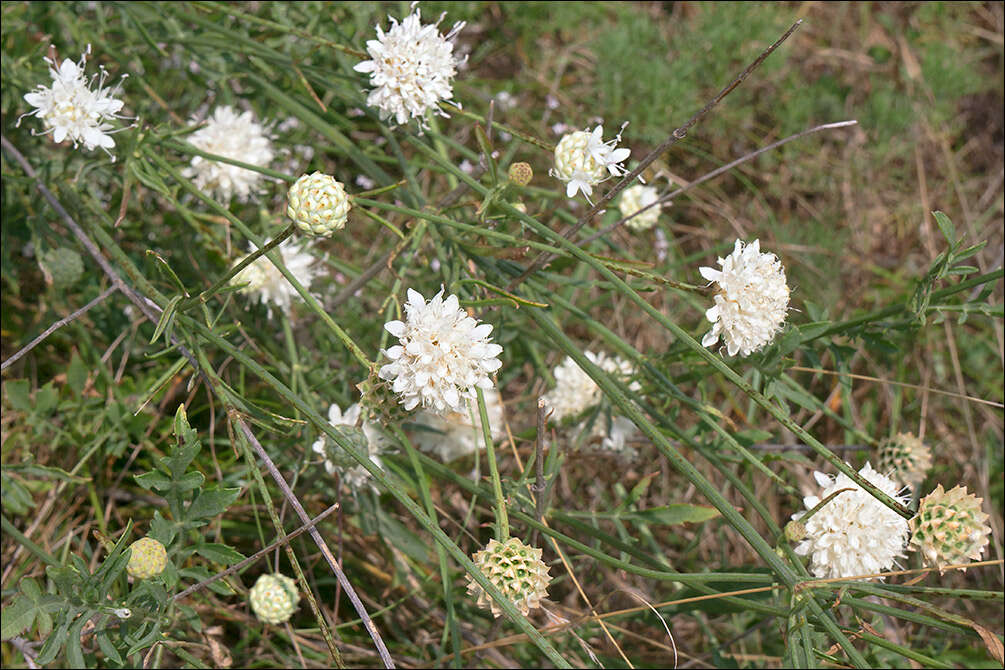
Cephalaria leucantha (L.) Roemer & Schultes, syn.: Scabiosa leucantha L., Scabiosa trenta HacquetEN: Giant Scabious, DE: Weier Schuppenkopf, Weibltiger Schuppenkopf, Weiblhender SchuppenkopfSlo.: bleda obloglavka, trentarski grintavecDat.: Aug. 25. 2019Lat.: 45.443873 Long.: 13.966619Code:Bot_1247/2019_DSC00544Habitat: dry grassland partly overgrown with scattered trees and bushes, locally flat terrain, skeletal, calcareous ground; open, sunny, dry place; elevation 485 m (1.919 feet);average precipitations 1.800 2.000 mm/year, average temperature 9-10 deg C, sub-Mediterranean phytogeographical region. Substratum: soil.Place: South of village Rakitovec (Slovenia), Kraki rob place, 900 m south of Slovenia/Croatia border crossing Rakitovec, next to the road toward town Buzet, Istria, Croatia EC. Comment: Cephalaria leucantha is a plant with a special significance in the history of Slovenian botany. It was first described more than 200 years ago in 1782 by Balthasar Hacquet. He was a medical doctor and an important scholar of very wide scope, living in the town Idria. Amon other activities he intensively researched Slovenian flora, particularly high in the Alps. A that time he described to the first time a beautiful, pale yellow plant found somewhere on the south slopes of Mt. Triglav above the Trenta valley. Exact location was lost. A dried specimen and Hacquet's drawing of the plant still exist in the herbarium of the Natural History Museum in Ljubljana. He named the new species Scabiosa trenta after the valley Trenta (note that some time ago Cephalaria leucantha was moved from genus Scabiosa to genus Cephalaria). After that the plant apparently 'disappeared' and hence became a botany riddle. Many botanists had been searching for it for more than 100 years, but none successfully. The plant became a great source of inspiration for later botanists and mountaineers of that time, especially for Julius Kugy, a German of Slovenian descent. He was writer, botanist, humanist, lawyer, musician and the father of modern mountaineering in the Julian Alps. He had searched for his beloved 'princes', as he named it, for almost all of his life. Much later Austrian botanist Anton Kerner found by careful inspection of the plant in the herbarium in Ljubljana that it doesn't represent a new Alpine species, as Hacquet was convinced, but a much more south growing Mediterranean plant Scabiosa leucantha (today named Cephalaria leucantha). So, the riddle was solved. It is quite possible that the plant, which Hacquet found, was among the last of its species growing in the Julian Alps and is now extinct from this region. Scabiosa trenta on the slopes of Mt. Triglav was probably a relic of warmer times between last ice ages. During that time many southern plants protruded far north into Alpine regions and were pushed back to the south by following colder climate. Nevertheless, Scabiosa trenta remains a strong symbol in Slovenian botany.The pictures shown here were taken at Kraki rob place in Croatia just 500 m southwest of Slovenia/Croatia border. But the plant can be found also in Slovenia in its warmest, southwest regions, however only in a few MTB squares. It also enters the most southwest parts of the Alps.Ref.:(1) D. Aeschimann, K. Lauber, D.M. Moser, J.P. Theurillat, Flora Alpina, Vol. 2., Haupt (2004), p 404.(2) A. Martini et all., Mala Flora Slovenije (Flora of Slovenia - Key) (in Slovenian), Tehnina Zaloba Slovenije (2007), p 499. (3) W.K. Rottensteiner, Exkursionsflora fr Istrien, Verlag des Naturwissenschaftlichen Vereins Krten (2014), p 423.(4) M. Blamey, C. Grey-Wilson, Wild Flowers of the Mediterranean, A & C Black, London (2005), p 425.
-
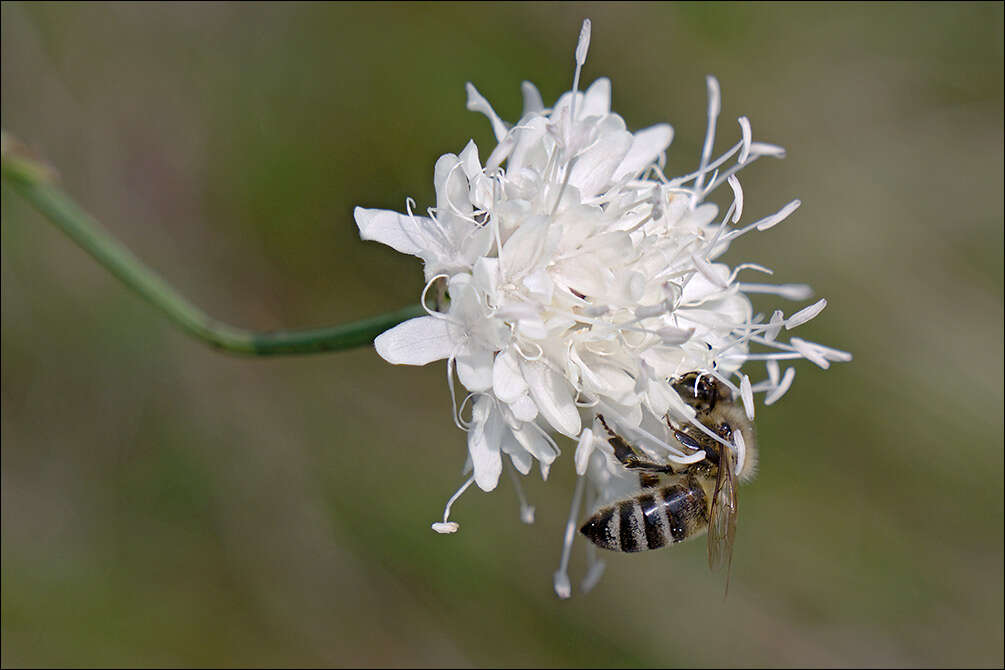
Cephalaria leucantha (L.) Roemer & Schultes, syn.: Scabiosa leucantha L., Scabiosa trenta HacquetEN: Giant Scabious, DE: Weier Schuppenkopf, Weibltiger Schuppenkopf, Weiblhender SchuppenkopfSlo.: bleda obloglavka, trentarski grintavecDat.: July 22. 2019 Lat.: 45.443873 Long.: 13.966619Code: Bot_1232/2019_DSC09021 Habitat: dry grassland partly overgrown with scattered trees and bushes, locally flat terrain, skeletal, calcareous ground; open, sunny, dry place; elevation 485 m (1.919 feet);average precipitations 1.800 2.000 mm/year, average temperature 9-10 deg C, sub-Mediterranean phytogeographical region. Substratum: soil.Place: South of village Rakitovec (Slovenia), Kraki rob place, 900 m south of Slovenia/Croatia border crossing Rakitovec, next to the road toward town Buzet, Istria, Croatia EC. Comment: Cephalaria leucantha is a plant with a special significance in the history of Slovenian botany. It was first described more than 200 years ago in 1782 by Balthasar Hacquet. He was a medical doctor and an important scholar of very wide scope, living in the town Idria. Amon other activities he intensively researched Slovenian flora, particularly high in the Alps. A that time he described to the first time a beautiful, pale yellow plant found somewhere on the south slopes of Mt. Triglav above the Trenta valley. Exact location was lost. A dried specimen and Hacquet's drawing of the plant still exist in the herbarium of the Natural History Museum in Ljubljana. He named the new species Scabiosa trenta after the valley Trenta (note that some time ago Cephalaria leucantha was moved from genus Scabiosa to genus Cephalaria). After that the plant apparently 'disappeared' and hence became a botany riddle. Many botanists had been searching for it for more than 100 years, but none successfully. The plant became a great source of inspiration for later botanists and mountaineers of that time, especially for Julius Kugy, a German of Slovenian descent. He was writer, botanist, humanist, lawyer, musician and the father of modern mountaineering in the Julian Alps. He had searched for his beloved 'princes', as he named it, for almost all of his life. Much later Austrian botanist Anton Kerner found by careful inspection of the plant in the herbarium in Ljubljana that it doesn't represent a new Alpine species, as Hacquet was convinced, but a much more south growing Mediterranean plant Scabiosa leucantha (today named Cephalaria leucantha). So, the riddle was solved. It is quite possible that the plant, which Hacquet found, was among the last of its species growing in the Julian Alps and is now extinct from this region. Scabiosa trenta on the slopes of Mt. Triglav was probably a relic of warmer times between last ice ages. During that time many southern plants protruded far north into Alpine regions and were pushed back to the south by following colder climate. Nevertheless, Scabiosa trenta remains a strong symbol in Slovenian botany.The pictures shown here were taken at Kraki rob place in Croatia just 500 m southwest of Slovenia/Croatia border. But the plant can be found also in Slovenia in its warmest, southwest regions, however only in a few MTB squares. It also enters the most southwest parts of the Alps.Ref.:(1) D. Aeschimann, K. Lauber, D.M. Moser, J.P. Theurillat, Flora Alpina, Vol. 2., Haupt (2004), p 404.(2) A. Martini et all., Mala Flora Slovenije (Flora of Slovenia - Key) (in Slovenian), Tehnina Zaloba Slovenije (2007), p 499. (3) W.K. Rottensteiner, Exkursionsflora fr Istrien, Verlag des Naturwissenschaftlichen Vereins Krten (2014), p 423.(4) M. Blamey, C. Grey-Wilson, Wild Flowers of the Mediterranean, A & C Black, London (2005), p 425.
-

